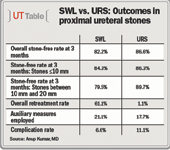Article
Shock wave lithotripsy vs. ureteroscopy: Stone size dictates choice of treatment
Although both shock wave lithotripsy and semi-rigid ureteroscopy can be seen as safe and effective approaches to treating proximal ureteral stones, the size of the stone should be a substantive consideration when choosing a technology.

Key Points
Delhi, India-Although both shock wave lithotripsy (SWL) and semi-rigid ureteroscopy (URS) can be seen as safe and effective approaches to treating proximal ureteral stones, the size of the stone should be a substantive consideration when choosing a technology, recent research indicates.
"Shock wave lithotripsy was the safer and less invasive treatment for upper ureteric stones 10 millimeters or smaller," first author Anup Kumar, MD, assistant professor of urology at Vardhman Mahavir Medical College and Safdarjung Hospital, Delhi, India, told Urology Times.
"Select your patients carefully and if there are no contraindications, use SWL. However, for upper ureteric stones larger than 10 mm-stones up to 20 mm-ureteroscopy is more effective. It has a lower retreatment rate," Dr. Kumar said.
They randomized 180 patients into two groups of 90 patients each. Those in group A were treated with SWL on an outpatient basis with an Alpha Compact electromagnetic lithotripter (Dornier MedTech, Kennesaw, GA). Group B patients were treated with a holmium laser or pneumatic intracorporeal lithotripter employed via 6/7.5F or 8/9.8F semirigid ureteroscope.
'Significant difference' in retreatment rates

A significant difference also appeared when comparing the treatments in patients with larger stones. At 3 months, 79.5% of SWL patients with stones between 10 mm and 20 mm were stone free compared to 89.7% of URS patients at 3 months.
Auxiliary measures were employed in 21.1% of the SWL patients and 17.7% of the URS patients. The complication rate was 6.6% for the SWL patients and 11.1% for URS patients. Neither of these differences was significant.
The paper, which was presented at the AUA annual meeting in San Francisco, was one of three randomized studies presented by Dr. Kumar and colleagues. A second study of 150 consecutive SWL patients concluded that a combination of oral ketorolac (Toradol), alprazolam (Xanax), and an occlusive dressing of EMLA (Euteric Mixture of Local Anesthesia) provides adequate analgesia with minimal morbidity while avoiding the need for parenteral analgesics.
A third study concluded that SWL was safe and efficacious when applied within 48 hours of the onset of colicky pain associated with proximal ureteral stones less than 1 cm.
ModernMedicine NETWORK
TOOLS
This free, customizable patient handout provides information on the causes, symptoms, and treatment of kidney stones. To view and print the handout, go to: http://www.urologytimes.com/stonehandout





